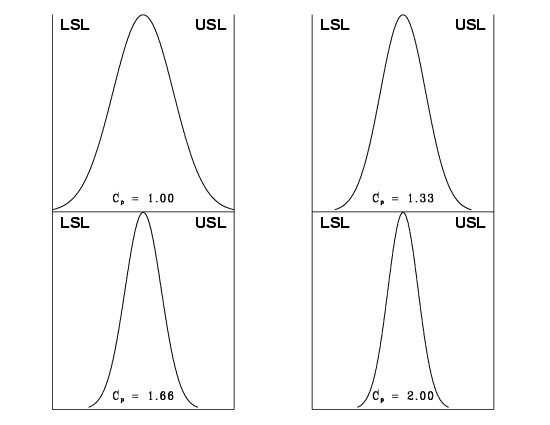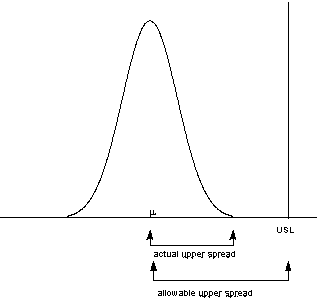6.1. Introduction
6.1.6. |
What is Process Capability? |
Process Capability Indices
A process where almost all the measurements fall inside the specification limits is a capable process. This can be represented pictorially by the plot below:

There are several statistics that can be used to measure the capability of a process: \(C_p\), \(C_{pk}\), and \(C_{pm}\).
Most capability indices estimates are valid only if the sample size used is "large enough". Large enough is generally thought to be about 50 independent data values.
The \(C_p\), \(C_{pk}\), and \(C_{pm}\) statistics assume that the population of data values is normally distributed. Assuming a two-sided specification, if \(\mu\) and \(\sigma\) are the mean and standard deviation, respectively, of the normal data and \(\mbox{USL}\), \(\mbox{LSL}\), and \(T\) are the upper and lower specification limits and the target value, respectively, then the population capability indices are defined as follows.
$$C_{pk} = \min{\left[ \frac{\mbox{USL} - \mu} {3\sigma}, \frac{\mu - \mbox{LSL}} {3\sigma}\right]} $$
$$ C_{pm} = \frac{\mbox{USL} - \mbox{LSL}} {6\sqrt{\sigma^2 + (\mu - T)^2}} $$
$$ \hat{C}_{p} = \frac{\mbox{USL} - \mbox{LSL}} {6s} $$
$$ \hat{C}_{pk} = \min{\left[ \frac{\mbox{USL} - \bar{x}} {3s}, \frac{\bar{x} - \mbox{LSL}} {3s}\right]} $$
$$ \hat{C}_{pm} = \frac{\mbox{USL} - \mbox{LSL}} {6\sqrt{s^2 + (\bar{x} - T)^2}} $$
The estimator for \(C_{pk}\) can also be expressed as \(C_{pk} = C_p(1-k)\), where \(k\) is a scaled distance between the midpoint of the specification range, \(m\), and the process mean, \(\mu\).
Denote the midpoint of the specification range by \(m = (\mbox{USL} + \mbox{LSL})/2\). The distance between the process mean, \(\mu\), and the optimum, which is \(m\), is \(\mu - m\), where \(m \le \mu \le \mbox{LSL}\). The scaled distance is $$ k = \frac{|m - \mu|} {(\mbox{USL} - \mbox{LSL})/2}, \;\;\;\;\;\; 0 \le k \le 1 \, .$$ (The absolute sign takes care of the case when \(\mbox{LSL} \le \mu \le m\)). To determine the estimated value, \(\hat{k}\), we estimate \(\mu\) by \(\bar{x}\). Note that \(\bar{x} \le \mbox{USL}\).
The estimator for the \(C_p\) index, adjusted by the \(k\) factor, is $$ \hat{C}_{pk} = \hat{C}_{p}(1 - \hat{k}) \, . $$ Since \(0 \le k \le 1\), it follows that \(\hat{C}_{pk} \le \hat{C}_{p}\).

This can be expressed numerically by the table below:
| \(\mbox{USL} - \mbox{LSL}\) | \(6 \sigma\) | \(8 \sigma\) | \(10 \sigma\) | \(12 \sigma\) |
| \(C_p\) | 1.00 | 1.33 | 1.66 | 2.00 |
| Rejects | 0.27 % | 64 ppm | 0.6 ppm | 2 ppb |
| % of spec used | 100 | 75 | 60 | 50 |
where ppm = parts per million and ppb = parts per billion. Note that the reject figures are based on the assumption that the distribution is centered at \(\mu\).
We have discussed the situation with two spec. limits, the \(\mbox{USL}\) and \(\mbox{LSL}\). This is known as the bilateral or two-sided case. There are many cases where only the lower or upper specifications are used. Using one spec limit is called unilateral or one-sided. The corresponding capability indices are
Estimators of \(C_{pu}\) and \(C_{pl}\) are obtained by replacing \(\mu\) and \(\sigma\) by \(\bar{x}\) and \(s\), respectively. The following relationship holds $$ C_p = \frac{C_{pu} + C_{pl}}{2} \, . $$ This can be represented pictorially by

Note that we also can write:
$$ C_{pk} = \mbox{min}(C_{pl}, \, C_{pu}) \, . $$
The resulting formulas for \(100(1-\alpha) \%\) confidence limits are given below.
Confidence Limits for \(C_p\) are $$ Pr\{\hat{C}_{p}(L_1) \le C_p \le \hat{C}_{p}(L_2)\} = 1 - \alpha \, ,$$ where $$ \begin{eqnarray} L_1 & = & \sqrt{\frac{\chi^2_{\alpha/2, \, \nu}}{\nu}} \, , \\ & & \\ L_2 & = & \sqrt{\frac{\chi^2_{1-\alpha/2, \, \nu}}{\nu}} \, , \end{eqnarray}$$ and \(\nu = \) degrees of freedom.
$$ C_{pu}(upper) = \hat{C}_{pu} + z_{1-\alpha}\sqrt{\frac{1}{9n} + \frac{\hat{C}_{pu}^{2}}{2(n-1)}} \, ,$$ with \(z\) denoting the percent point function of the standard normal distribution. If \(\beta\) is not known, set it to \(\alpha\).
Limits for \(C_{pl}\) are obtained by replacing \(\hat{C}_{pu}\) by \(\hat{C}_{pl}\).
The variance is obtained as follows.
Let
-
$$ c = \sqrt{n}\left[\mu - (\mbox{USL} + \mbox{LSL})/2\right]\sigma $$
$$ d = (\mbox{USL} - \mbox{LSL})/\sigma $$
$$ \Phi(-c) = \int_{-inf}^{-c}{\frac{1}{\sqrt{2\pi}}\exp{-5z^2}dz} \, .$$
-
$$ Var(\hat{C}_{pk}) $$
$$ = (d^2/36)(n-1)(n-3) $$
$$ -(d/9\sqrt{n})(n-1)(n-3)\{\sqrt{2\pi}\exp{(-c^2/2)} + c[1 - 2\Phi(-c)]\} $$
$$ +[(1/9)(n-1)/(n(n-3))](1+c^2) $$
$$ -[(n-1)/(72n)]\{\frac{\Gamma((n-2)/2)}{\Gamma((n-1)/2)}\}^2 $$
$$ *\{d\sqrt{n} - 2\sqrt{2\pi}\exp{(-c^2/2)} - 2c[1 - 2\Phi(-c)]\}^2 \, .$$
-
$$ Var(\hat{C}_{pk}) = \frac{n-1}{n-3} - 0.5\{\frac{\Gamma((n-2)/2)}{\Gamma((n-1)/2)}\}^2 \, , $$
-
$$ n \ge 25, \,\,\,\,\,\, 0.75 \le C_{pk} \le 4, \,\,\,\,\,\, |c| \le 100, \,\,\,\,\,\,
\mbox{ and } \,\,\,\,\,\, d \le 24 \, .$$
But it doesn't, since \(\bar{x} \ge 16\). The \(\hat{k}\) factor is found by $$ \hat{k} = \frac{|m - \bar{x}|} {(\mbox{USL} - \mbox{LSL})/2} = \frac{2} {6} = 0.3333 $$ and $$ \hat{C}_{pk} = \hat{C}_{p}(1-\hat{k}) = 0.6667 \, .$$ We would like to have \(\hat{C}_{pk}\) at least 1.0, so this is not a good process. If possible, reduce the variability or/and center the process. We can compute the \(\hat{C}_{pu}\) and \(\hat{C}_{pl}\) using $$ \hat{C}_{pu} = \frac{\mbox{USL} - \bar{x}} {3s} = \frac{20 - 16} {3(2)} = 0.6667 $$ and $$ \hat{C}_{pl} = \frac{\bar{x} - \mbox{LSL}} {3s} = \frac{16 - 8} {3(2)} = 1.3333 \, . $$ From this we see that the \(\hat{C}_{pu}\), which is the smallest of the above indices, is 0.6667. Note that the formula \(\hat{C}_{pk} = \hat{C}_{p}(1 - \hat{k})\) is the algebraic equivalent of the \(\mbox{min}(\hat{C}_{pu}, \, \hat{C}_{pl})\) definition.
- Transform the data so that they become approximately normal. A
popular transformation is the
Box-Cox
transformation
- Use or develop another set of indices, that apply to nonnormal
distributions. Non-parameteric versions
(Pearn, Tai, Hsiao, and Ao
(2014) and
Chen and Ding (2001))
of the \(C_{p}\), \(C_{pk}\), and \(C_{pm}\) capability indices
are denoted by \(C_{np}\), \(C_{npk}\), and \(C_{npm}\).
Estimators for these non-parameteric capability indices are
calculated by
-
\( \hat{C}_{np} = \frac{\mbox{USL} - \mbox{LSL}}
{p(0.99865) - p(0.00135)} \)
\( \hat{C}_{npk} = \frac{\mbox{min}\left[ \mbox{USL} - median, median - \mbox{LSL} \right] } {(p(0.99865) - p(0.00135))/2 } \)
\( \hat{C}_{npm} = \frac{\mbox{USL} - \mbox{LSL}} {6 \sqrt{\left( \frac{p(0.99865) - p(0.00135)}{6} \right) ^2 + (median - \mbox{T})^2}} \)
where \(p(0.99855)\) is the 99.865th percentile of the data and \(p(0.00135)\) is the 0.135th percentile of the data. The use of these percentiles is justified to mimic the coverage of ±3 standard deviations for the normal distribution. Note that some sources may use 99% coverage. For example, the \(C_{npk}\) statistic may be given as
-
\( \hat{C}_{npk} = \mbox{min}\left[\frac{\mbox{USL} - median}
{p(0.995) - median},
\frac{median - \mbox{LSL}}{median - p(0.005)} \right] \)
where \(p(0.995)\) is the 99.5th percentile of the data and \(p(0.005)\) is the 0.5th percentile of the data.
For additional information on nonnormal distributions, see Johnson and Kotz (1993).
There is, of course, much more that can be said about the case of nonnormal data. However, if a Box-Cox transformation can be successfully performed, one is encouraged to use it.

